|
|
 |
|
April 30, 2012
Graduation and Weddings clearly call for celebratory bubbles, and the same goes for Mother’s and Father’s day. Of course, you could skimp on the wine or pick up a mass-market bottle at the last second. But then you’d be running a major risk, since it could turn out that reincarnation really exists: If you buy something for $9 in a black bottle for a wedding or your Mama, you might spend your next life as a dung beetle.
Don’t spend your next life as a dung beetle. Do a little legwork and get something terrific to celebrate the big day. Here are three extraordinary options that will set you on an upward trajectory whenever you confront the Great Beyond:
Mont Marcal, Cava Brut Reserva “Extremarium,” Penedes, Spain, NV ($25, Classical Wines): Full disclosure requires that I acknowledge that I’m not a big fan of Cava, and that I 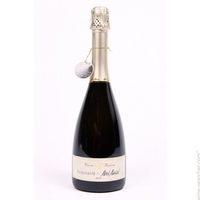 have spent my own money to buy it exactly once during the past twenty years (for a Spanish-themed wedding party that happened to be my own). With that said, however, my credibility in praising this wine should be pretty damned solid. This is a stop-you-in-your-tracks Cava, and that’s exactly what it did to me. Whereas most cava is rather rustic, with a wet straw character that is less endearing on the third sniff-and-sip than it is on the first, this wine is clean and fresh and engaging in both aroma and flavor. And in texture too: Even prestige-level cavas can be notably coarse in effervescence by comparison to fine Champagnes, but this wine has a marvelously creamy feel. That really enhances the soft, generous aromas and flavors of the wine, which show a gorgeous lemon chiffon character as well as a baked apple backnote. It is absolutely gorgeous from stem to stern, and can soften even the hardest core cava skeptic. I should know, right? 92 have spent my own money to buy it exactly once during the past twenty years (for a Spanish-themed wedding party that happened to be my own). With that said, however, my credibility in praising this wine should be pretty damned solid. This is a stop-you-in-your-tracks Cava, and that’s exactly what it did to me. Whereas most cava is rather rustic, with a wet straw character that is less endearing on the third sniff-and-sip than it is on the first, this wine is clean and fresh and engaging in both aroma and flavor. And in texture too: Even prestige-level cavas can be notably coarse in effervescence by comparison to fine Champagnes, but this wine has a marvelously creamy feel. That really enhances the soft, generous aromas and flavors of the wine, which show a gorgeous lemon chiffon character as well as a baked apple backnote. It is absolutely gorgeous from stem to stern, and can soften even the hardest core cava skeptic. I should know, right? 92
Lilbert-Fils Champagne Grand Cru Blanc de Blancs Brut, France, NV ($51, Vintage ’59 Imports): If there is a producer in Champagne making more impeccably fresh, stylish Blanc de Blancs wines today, then I am unaware of it. I have loved these wines for years, and, being an admirer but also a critic by profession, have always been on guard for a bottle that would show a dip in quality. I’ve never seen one, and indeed the two bottles of Lilbert NV that I tasted  during the past two weeks were among the best I’ve ever tried. The key to the excellence of Lilbert’s non-vintage wine (a vintage-dated Grand Cru Brut is the house’s only other offering) is a precise balance between austerity and generosity, and the accent here is on the word, precise: On one hand, this is a subtle, restrained, linear, sharply focused wine rather than an in-your-face blast of fruit and yeast. On the other hand, the wine is never stingy, but rather subtly satisfying, showing a focused and persistent beam of fruit recalling green apples and ripe lemons. Faintly toasty accents and a hint of minerality lend complexity to the finish, which is exceptionally persistent and refreshing, thanks in large part to very fine mousse that is stylistically in keeping with the wine’s overall flavor profile. If I’ve made myself clear here, you’ll understand that this is not a bombastic wine and not the best choice for bowling over a novice. It sounds snotty to say so, but this is a connoisseur’s wine, a Champagne of exceptional refinement. 94 during the past two weeks were among the best I’ve ever tried. The key to the excellence of Lilbert’s non-vintage wine (a vintage-dated Grand Cru Brut is the house’s only other offering) is a precise balance between austerity and generosity, and the accent here is on the word, precise: On one hand, this is a subtle, restrained, linear, sharply focused wine rather than an in-your-face blast of fruit and yeast. On the other hand, the wine is never stingy, but rather subtly satisfying, showing a focused and persistent beam of fruit recalling green apples and ripe lemons. Faintly toasty accents and a hint of minerality lend complexity to the finish, which is exceptionally persistent and refreshing, thanks in large part to very fine mousse that is stylistically in keeping with the wine’s overall flavor profile. If I’ve made myself clear here, you’ll understand that this is not a bombastic wine and not the best choice for bowling over a novice. It sounds snotty to say so, but this is a connoisseur’s wine, a Champagne of exceptional refinement. 94
Ayala, Champagne Brut “Majeur,” France, NV ($49, Imported by Cognac One): For more 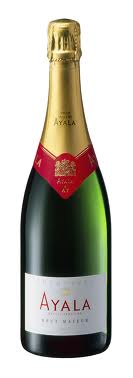 than a year I’ve been hearing about how good the wines of Ayala have become from my WRO colleague Ed McCarthy, and yet I was still not adequately prepared for the experience of this wine. It is the single most impressive standard-issue non-vintage brut Champagne that I’ve tasted in years. An extraordinarily dramatic wine, it is explosively aromatic, and virtually billows with scents of fresh bread crust and baker’s yeast, along with toasty, nutty notes. The flavors are mature in their ripeness and depth, and the wine’s relatively deep color also indicates the presence of a significant portion of reserve wines (or a long span of ageing sur pointe, or both). Despite all of these dramatics, the wine remains admirably fresh and balanced rather than heavy or excessively oxidized, and the finish is clean and precise. To be clear: This tastes for all the world like a cuvée prestige, and yet is priced at about half of that category of wines, making this a stunning value in addition to being a stunning wine. 94
Posted by Michael Franz at 5:14 PM than a year I’ve been hearing about how good the wines of Ayala have become from my WRO colleague Ed McCarthy, and yet I was still not adequately prepared for the experience of this wine. It is the single most impressive standard-issue non-vintage brut Champagne that I’ve tasted in years. An extraordinarily dramatic wine, it is explosively aromatic, and virtually billows with scents of fresh bread crust and baker’s yeast, along with toasty, nutty notes. The flavors are mature in their ripeness and depth, and the wine’s relatively deep color also indicates the presence of a significant portion of reserve wines (or a long span of ageing sur pointe, or both). Despite all of these dramatics, the wine remains admirably fresh and balanced rather than heavy or excessively oxidized, and the finish is clean and precise. To be clear: This tastes for all the world like a cuvée prestige, and yet is priced at about half of that category of wines, making this a stunning value in addition to being a stunning wine. 94
Posted by Michael Franz at 5:14 PM
|
|
April 27, 2012
These are the best of times for the vignerons of Burgundy and Bordeaux,
arguably the world's most important — certainly the most famous — vineyard
lands.
Over the course of the past three weeks, I've had the rare
opportunity to immerse myself in the wines of both regions, tasting all of the
most recent vintages as well as a number of older wines, including a fair
sampling from the controversial 2003 harvest.
As I reflect upon the
experience, a few observations come quickly to mind.
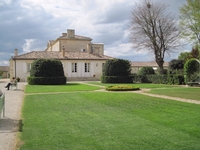 The Bordelaise have never had it so good. In my experience, the only
stretch that compares to the run of good vintages in 2009, 2010 and 2011 is the
outstanding trio of vintages from 1988 through 1990. The latter three were all
very good, and 1988 will likely go down as one of the most underrated Bordeaux
vintages of all time. But the current streak is much better than that because
2009 and 2010 are superior to 1989 and 1990. And despite all the hype over the
vaunted 2009 vintage, in my humble opinion 2010 is even better. The Bordelaise have never had it so good. In my experience, the only
stretch that compares to the run of good vintages in 2009, 2010 and 2011 is the
outstanding trio of vintages from 1988 through 1990. The latter three were all
very good, and 1988 will likely go down as one of the most underrated Bordeaux
vintages of all time. But the current streak is much better than that because
2009 and 2010 are superior to 1989 and 1990. And despite all the hype over the
vaunted 2009 vintage, in my humble opinion 2010 is even better.
Although
the quality in 2011 isn't as even throughout the region as it was in 2009 and
2010, the wines from the top chateaux in the better districts are just as good.
If you accept the evaluation that 2008 is a sleeper vintage, much better than
advertised, then you could also point to a four-year run of high quality
vintages that would be unprecedented in the history of Bordeaux.
The big
issue in Bordeaux at the moment is pricing. The top wines are simply too
expensive for the American market, except for those who purchase for investment
purposes and intend to put their stocks on the auction market at some point.
Driving the price ever higher is the recent and intense interest from the
Chinese market. The Chinese also, to some extent, are playing a big role in the
red-hot auction market, as well as the red-hot "after" market for older vintages
of Bordeaux from the top chateaux. The fear is that Bordeaux will eventually
lose the American market to equally fashionable but less expensive fine wines.
No one wants to lose the American market, but the possibility is very
real.
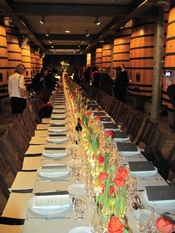 The 2003
vintage was hailed as a "miracle" when the wines were first presented "en
primeurs" during the spring of 2004. The miracle was that the Bordelaise had
somehow survived the heat wave that gripped all of Europe in the summer of 2003,
turning many of the grapes in the most famous vineyards into raisins. Turns out
the kudos were both premature and flat-out undeserved. The 2003 Bordeaux are
pretty much a disaster. The tannins, masked by uber-ripe fruit when young, are
extremely coarse, and the wines lack elegance. You can drink them now, but you
likely won't enjoy them so much. But better now than a year or two from now. "No
one had seen or experienced such a vintage," said Stephane Pariaud of Chateau
Greysac in the Medoc. "Having been through it once, all of the chateaux would be
better able to cope with such extreme heat, and would make better wine." Now
they tell us. The 2003
vintage was hailed as a "miracle" when the wines were first presented "en
primeurs" during the spring of 2004. The miracle was that the Bordelaise had
somehow survived the heat wave that gripped all of Europe in the summer of 2003,
turning many of the grapes in the most famous vineyards into raisins. Turns out
the kudos were both premature and flat-out undeserved. The 2003 Bordeaux are
pretty much a disaster. The tannins, masked by uber-ripe fruit when young, are
extremely coarse, and the wines lack elegance. You can drink them now, but you
likely won't enjoy them so much. But better now than a year or two from now. "No
one had seen or experienced such a vintage," said Stephane Pariaud of Chateau
Greysac in the Medoc. "Having been through it once, all of the chateaux would be
better able to cope with such extreme heat, and would make better wine." Now
they tell us.
Burgundy is riding the quality wave much as the producers
and negociants are in Bordeaux, having experienced back-to-back outstanding
harvests, though the 2009 vintage in Burgundy is not at the same level as the
2009 vintage in Bordeaux.
It was a warm year that produced generous,
fleshy wines that have immediate drinkability and appeal. The whites are
slightly lower in acid than normal and may not age as well as usual, but they
are delicious now. The reds are riper and softer, too, and will be attractive to
drink much earlier than usual.
The 2010
vintage, however, is a classic and rivals Bordeaux 2010 in quality. It will be a
good year to load up on Bourgogne and village wines, for all sectors saw quality
rise. For my cellar I am deeply interested in premier cru reds from the Cote de
Nuits and premier cru whites from the Cote de Beaune. Unlike the top wines of
Bordeaux, I can actually afford premier cru Burgundy.
Over the course of
a week in Burgundy, I had the opportunity to taste a number of older vintages,
both at professional trade tastings and while dining out. The 2007 vintage was
everywhere, and now I understand why it has popped up on so many wine lists in
and around Beaune. The 2007s have matured quickly and now exhibit advanced
secondary aromas (tobacco, leather, mushrooms) that you might expect to find in
much older wines. The wines from 2007 that I tasted were far from awful, but it
was apparent they have already passed their peak and will not last. If you
happen to have 2007 red Burgundy on your rack, you may want to think about
consuming it sooner rather than later. As they say, "Drink up!"
Posted by Robert Whitley at 9:46 AM
|
|
April 24, 2012
Every couple of years or so I get the urge to sound off once again about the marvels of Riesling. This time, it’s a proclamation from an organization called the Finger Lakes Wine Country announcing that May is Riesling Month that prompts me to extoll in advance the many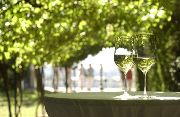 marvels of Riesling. And so, with apologies to Elizabeth Barrett Browning, I ask: How do I love thee, Riesling? Let me count the ways… marvels of Riesling. And so, with apologies to Elizabeth Barrett Browning, I ask: How do I love thee, Riesling? Let me count the ways…
1. Gorgeous Fragrance. Jancis Robinson has described Riesling’s distinctive perfume perfectly. “Riesling wine, wherever produced” she wrote, “is notable for its powerful, rapier -like aroma variously described as flowery, steely, honeyed, and whichever blend of mineral elements is conveyed by the vineyard site.”
2. Stylistic Versatility. What other white wine can be perfectly bone dry, medium dry, or sweet, sweeter and sweetest?
3. Modest Alcohol Levels. While many late harvest and other Rieslings sumptuously endowed with residual sugar may contain serious amounts of alcohol, you will more commonly find Rieslings with easy-to-imbibe alcohol levels ranging from 8 to 13%.
4. Extraordinary Complexity. High-sugar Riesling dessert wines are among the most complex (and expensive) wines in the world. The sweetness results from concentration of the sugars due to evaporation caused by botrytis cinerea (or “noble rot”) or from freeze concentration in ice wines (eiswein in German). Massively rich and sweet but freshened by energetic acidity, these are among the world’s most striking and memorable wines.
5. Geographic Adaptability. From Germany (where it is thought to have originated) to Austria and France’s Alsace; from Australia and New Zealand, California and Canada, China and Ukraine; and from South Africa to New York’s Finger Lakes--Riesling is thriving across the globe. As it is a particularly terroir-driven grape, the best made Rieslings emerging from these disparate places tend to be individually characterful yet true to their origins.
6. Hardiness. Riesling thrives in cool climates where other vinifera vines don’t stand a chance of survival (in warmer zones Riesling grapes can get fat and flabby, and lose the acidic zip we love so much). Riesling vines also flourish in poor soils, especially in rocky terrain that forces the roots to reach far down through the slate, granite, volcanic basalt or limestone in search of water. Many people believe that this is what produces the unique mineral flavors found in fine Riesling.
7. Gastronomic versatility. Thanks in part to that low alcohol content Riesling is a favorite aperitif wine. Many gourmands also consider it the best wine to drink with spicy foods. It is definitely the wine of choice to have with Choucroute or most other dishes featuring sauerkraut. “Riesling is hands-down the best food wine in the world,” according to a recent Sunset post on the Magazine’s web site citing the wine’s “balance of intense acidity, minerality and fruit” which makes it a uniquely fine match for all manner of dishes, from sushi to onion rings to veal.
8. Ageability. Riesling, wrote Jancis Robinson, “could claim to be the finest white grape 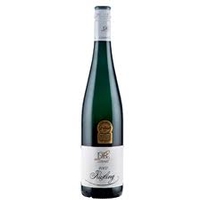 variety in the world on the basis of the longevity of its wines.” Excellent ten, twenty or even fifty-year old Rieslings are not even considered newsworthy. We Americans seem to have little patience (or proper storage space) for letting wines age, but among many connoisseurs the world over Riesling is renowned for its capacity to age beautifully for decades. “In Germany we have a long tradition of drinking aged Riesling,” says Ernst Loosen, owner and winemaker at Dr. Loosen Estate. That reminds me--I’ve got a bottle of 2009 Dr. Loosen lying quietly on its side on a wine rack in my basement. I’d been planning to leave it there to age for at least another two or three years, but after all this ruminating on the subject I’ve developed a fierce thirst for Riesling. Perhaps I’ll let the wine mature a bit longer--say another couple of hours--then I’ll put it in the fridge to be savored with tonight’s dinner…. variety in the world on the basis of the longevity of its wines.” Excellent ten, twenty or even fifty-year old Rieslings are not even considered newsworthy. We Americans seem to have little patience (or proper storage space) for letting wines age, but among many connoisseurs the world over Riesling is renowned for its capacity to age beautifully for decades. “In Germany we have a long tradition of drinking aged Riesling,” says Ernst Loosen, owner and winemaker at Dr. Loosen Estate. That reminds me--I’ve got a bottle of 2009 Dr. Loosen lying quietly on its side on a wine rack in my basement. I’d been planning to leave it there to age for at least another two or three years, but after all this ruminating on the subject I’ve developed a fierce thirst for Riesling. Perhaps I’ll let the wine mature a bit longer--say another couple of hours--then I’ll put it in the fridge to be savored with tonight’s dinner….
Posted by Marguerite Thomas at 3:42 PM
|
|
April 18, 2012
It’s clear early on that this is going to be one of those days: no time to shop, no time to cook. My husband and I decide that one of us will stop at Chipotle on the way home this evening and pick up some tacos for dinner. While considering, in advance, what sort of wine might be best with Mexican takeout, I decide to focus only on white options. Next time, perhaps, I’ll think about the red possibilities. Of course there’s always Rosé too, which can be good with spicy 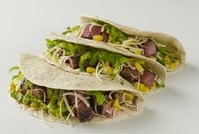 food. And let’s not overlook sparkling wine, which is infinitely adaptable to a variety of foods. Are there grants available for ongoing research of this sort, I wonder? food. And let’s not overlook sparkling wine, which is infinitely adaptable to a variety of foods. Are there grants available for ongoing research of this sort, I wonder?
Getting back to the basics, I’d better put some white wine in the fridge for tonight. But what kind of wine? Some experts think fresh, crisp white wine is best with spicy food, while an overwhelming majority of food and wine pairing aficionados swear that sweeter aromatic selections are more appropriate. I’m torn. I can see the philosophical arguments on each side but can’t decide where to place my bet.
I root around the white wines stored in our basement looking for a sample of each style. This is takeout we’re talking about, so although I’m not searching for rock bottom prices in this instance, I do want wines that would cost less than $20. I find a bottle of Robert Oatley 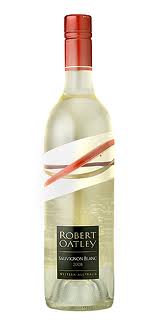 Sauvignon Blanc, a good example of a refreshing wine with bright but not shrill acidity. And here’s the fruity but not over-the-top Pacific Rim Sweet Riesling I was looking for. And now, with both bottles chilling, I can get on with the rest of the day. Sauvignon Blanc, a good example of a refreshing wine with bright but not shrill acidity. And here’s the fruity but not over-the-top Pacific Rim Sweet Riesling I was looking for. And now, with both bottles chilling, I can get on with the rest of the day.
To make this a more complete experiment, when I arrive at Chipotle I order two kinds of tacos: Beef with spicy salsa, and pork with mild salsa. I ask for them to be folded into soft corn tortillas and topped with cheese, lettuce, tomato, guacamole and a dab of sour-cream.
Back home, we dig enthusiastically into the tacos and savor the way the icy Sauvignon Blanc delivers a clean sweep of citrusy flavor that refreshes palates blasted by hot spice. The wine’s slight herbal grassiness furthermore connects tastily with the tang of fresh cilantro that’s prevalent in the milder salsa. The Riesling, by contrast, offers ripe, peachy-pineapple tropical fruit flavors that bring out the full-bodied succulence of the pork, as well as the richness of cheese and sour cream. It also softens the sting of spiciness that infuses the beef taco. Honestly, it’s a bit of a draw. I’d expected to find a clear favorite between these two styles of wine, but each of them in its own way is appealing with the pair of tacos.
I would never contest the point that the right match-up between a given food and its accompanying wine make both of them taste even better. On the other hand, there’s usually more than one “correct” answer to what-goes-with-what. Sometimes it’s a question of mood as much as food. And once in awhile the guidelines we depend on should be put to the test. We all tend to get stuck in our pairing patterns, but since food and wine both have more versatility on the palate than we generally give them credit for it can be enlightening to think outside the box, if you’ll pardon the cliché. As Katharine Hepburn is credited with saying, “If you obey all the rules you miss all the fun.”
Posted by Marguerite Thomas at 10:32 AM
|
|
April 13, 2012
BORDEAUX, France — It was only last night that I
visited the iconic restaurant La Tupina, in the heart of the old section
of Bordeaux. La Tupina specializes in the cuisine of southwest France,
and it still does things the old fashioned way, grilling its meats over a
wood fire.
If the food at La Tupina is extraordinary, the wine
list is the next level up, whatever level that might be. The offerings
are arranged by price, so when I thumbed all the way to the back page, I
found the ultimate garagiste wine, Le Pin, that I could have had for a mere 7,000 euros (approximately $9,300).
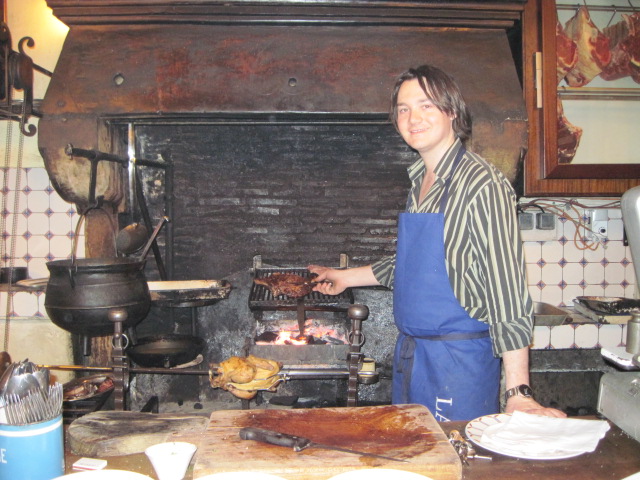 I
opted instead for a half bottle of the superb cru bourgeois Chateau de
Pez, a Saint-Estephe from the outstanding 2005 vintage, and saved $6,945
euros for another day. I
opted instead for a half bottle of the superb cru bourgeois Chateau de
Pez, a Saint-Estephe from the outstanding 2005 vintage, and saved $6,945
euros for another day.
Dining out in France, with wine, can be
an expensive proposition even in a modest bistro, which makes it all the
more important a traveler chooses wisely when deciding where to go. It
will almost never be cheap, but at least you should eat well.
From
my experiences of the past two weeks, I can offer a few recommendations
should your vacation plans include a trip to France to sample the wines
and enjoy the cuisine.
In Paris, my ambitions for the wine and
food experience run the gamut from bistro to brasserie to the ultimate
in gastronomy, the restaurant with a coveted Michelin star, or two.
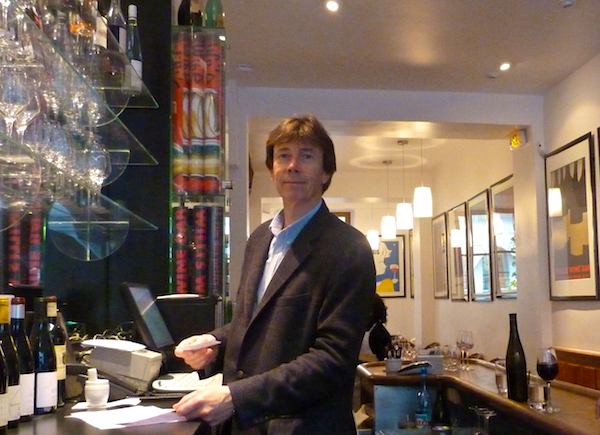 On
my recent visit, I took in Willi's Wine Bar, the much-heralded bistro
and the first modern wine bar in Paris, established more than 30 years
ago by a Brit named Mark Williamson. The food at Willi's is solid, and
the wine list heavy on selections from France's Rhone Valley, although
Burgundy, Bordeaux and the Loire are represented, as well. On
my recent visit, I took in Willi's Wine Bar, the much-heralded bistro
and the first modern wine bar in Paris, established more than 30 years
ago by a Brit named Mark Williamson. The food at Willi's is solid, and
the wine list heavy on selections from France's Rhone Valley, although
Burgundy, Bordeaux and the Loire are represented, as well.
At
Willi's, the discerning wine lover doesn't have to settle for the
ubiquitous "verre de vin blanc" or "vin rouge" that is the nameless,
generic wine-by-the glass offering at most bistros. Williamson, as
knowledgeable on wine as anyone I've ever met, hand picks the daily
wine-by-the-glass offerings.
While the food and wine are good,
Willi's may be most famous for its annual poster art. Wine enthusiasts
often come to Willi's simply to purchase the latest poster, or perhaps
one that is missing from their collection.
Willi's appeals to me because it has never tried to be anything more than it is.
"Our
aim is to serve simple bistro fare with unfussy service," Williamson
told me when I stopped in before my trek to Bordeaux. I like to sit at
the bar at Willi's, but the table service is cozy and comfortable if a
bit cramped. Willi's is easy to find, located as it is on the Right
Bank, just behind the Palais Royal on Rue des Petit Champs, and a
three-course prix fixe menu costs around $50 ($75 to $80 with wine).
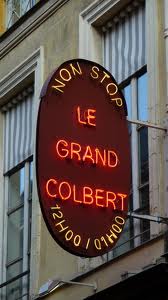 Just
around the corner from Willi's, literally steps away, is Le Grand
Colbert, the famous Paris brasserie that was immortalized in the movie
"Something's Gotta Give." Some regulars complain that the fame showered
upon Le Grand Colbert by the success of the movie has turned this
Parisian dining spot into a tourist trap. I would tend to disagree, but
let's face it, if a restaurant in Paris has a good reputation, it's
going to attract foreign visitors. That's Paris! Just
around the corner from Willi's, literally steps away, is Le Grand
Colbert, the famous Paris brasserie that was immortalized in the movie
"Something's Gotta Give." Some regulars complain that the fame showered
upon Le Grand Colbert by the success of the movie has turned this
Parisian dining spot into a tourist trap. I would tend to disagree, but
let's face it, if a restaurant in Paris has a good reputation, it's
going to attract foreign visitors. That's Paris!
The cliche dish
to order at Le Grand Colbert is the roast half chicken, because that's
the signature dish touted in the movie — but the chicken really is good,
and the portion is large enough for two people to split. So split one
of the impressive seafood platters as a starter and split the chicken as
your entree, and you will have plenty of room left for a profiterole,
one of the best in Paris.
The wine list at Le Grand Colbert is
quite good, with many offerings at reasonable prices, including a good
selection of half bottles for those going the seafood followed by meat
route. All in all, expect a meal there to cost around $100.
Now for dining on a grand scale, there is no place like Paris, and for the single diner, no place like L'Atelier Joel Robuchon.
The
first thing that will strike you about this restaurant is the absence
of dining tables. Everyone eats at the bar, with a bird's-eye view of
everything that goes on in the kitchen.
It's sort of like
sitting at the counter at your neighborhood diner, but not really.
L'Atelier has two Michelin stars, and Joel Robuchon is perhaps one of
the world's five most famous chefs. It has been my habit in recent years
to pop in on L'Atelier at its location in Saint-Germain des Pres, just
off the lobby of the Pont Royal Hotel.
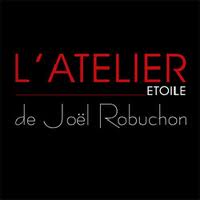 On
this most recent visit, I discovered L'Atelier now has a second
location, on the Champs Elysees just a block or so from the Arc de
Triomphe. They are distinguished from each other as L'Atelier
Saint-Germain and L'Atelier Etoile. The second location also has two
Michelin stars and is much easier to be seated if you are more than a
party of one because it takes reservations. The Sanit-Germain location
only takes reservations for the first seating at 6:30 p.m. On
this most recent visit, I discovered L'Atelier now has a second
location, on the Champs Elysees just a block or so from the Arc de
Triomphe. They are distinguished from each other as L'Atelier
Saint-Germain and L'Atelier Etoile. The second location also has two
Michelin stars and is much easier to be seated if you are more than a
party of one because it takes reservations. The Sanit-Germain location
only takes reservations for the first seating at 6:30 p.m.
I
sometimes order the degustation menu at L'Atelier, but more often than
not I go in craving the jamon Iberico, which is as good as any you will
find in Spain, and the langostines. And the selection of wines by the
glass is superb, among the finest in France.
L'Atelier is
expensive. A single diner with wine should expect to spend in excess of
$200, even ordering a la carte. The degustation menu will be more.
So
with what I saved by passing on the Le Pin at 7,000 euros, I see many
more visits to L'Atelier, Willi's and Le Grand Colbert in my future
Paris travels!
Posted by Robert Whitley at 10:35 AM
|
|
April 12, 2012
Stop laughing. Exceptional Bordeaux that's fairly cheap -- all things considered -- does exist, and I was reminded of that fact over the course of tasting primeurs samples of the 2011 vintage last week in Bordeaux.
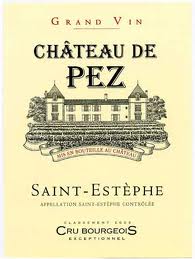 Among the wines that stood out were those from three chateaux on the Left Bank that have overdelivered -- based on relatively modest pedigree -- in recent vintages. The three -- Chateau de Pez St. Estephe, Chateau Siran Margaux and Chateau Gloria St. Julien -- all hail from good neighborhoods, but none are likely to attract the attention of wealthy Chinese wine buyers out to impress their friends. Among the wines that stood out were those from three chateaux on the Left Bank that have overdelivered -- based on relatively modest pedigree -- in recent vintages. The three -- Chateau de Pez St. Estephe, Chateau Siran Margaux and Chateau Gloria St. Julien -- all hail from good neighborhoods, but none are likely to attract the attention of wealthy Chinese wine buyers out to impress their friends.
On the other hand, Bordeaux collectors who've started to gag at the price of First and Second Growth chateaux may want to take a closer look at some of the properties making sensational wines without the burden of great expectations, and the price that comes with notoriety.
The 2009 Chateau de Pez can be found on the internet for less than $40, and the 2011 vintage should be even less. A few critics, myself included, have a high regard for 2011, but no one places it in the same league with either 2010 or 2009.
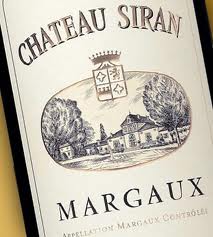 I found both Chateau Gloria and Chateau Siran from 2009 for less than $30 a bottle on the internet. If the 2011 vintages of those two chateaux come in under that, they may rank as the steals of the vintage. I found both Chateau Gloria and Chateau Siran from 2009 for less than $30 a bottle on the internet. If the 2011 vintages of those two chateaux come in under that, they may rank as the steals of the vintage.
All three wines exhibited exceptional structure and character at the 2011 Primeurs tastings and should hold up nicely for a decade or more in a good cellar. These chateaux may not score you any points with the wine snobs in your circle, but they will fill your cellar with first-class Bordeaux from a good vintage at an attractive price.
|
Posted by Robert Whitley at 10:04 AM
|
|
April 2, 2012
I received an email recently from winemaker Mark Lyon, bringing me up to date on his investigation into using horse-power in the Sebastiani vineyards in California. Real horses, of course. Mark is on his way this month to Chateau Pontet-Canet, the esteemed Left Bank Bordeaux producer, for further research. After a decade of meticulously detailed vineyard management Pontet-Canet now qualifies for100% Biodynamic certification (ECOCERT and BIODIVIN). One of the dramatic and colorful “green” changes in the vineyard is the presence 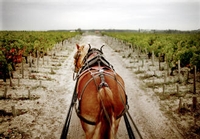 of Kakou, Reine, Opal and Surprise, the four draft horses who have been brought in to help plow the vineyards. of Kakou, Reine, Opal and Surprise, the four draft horses who have been brought in to help plow the vineyards.
One might be forgiven for thinking that the presence of horse-powered plows in the vineyard is a quaint, gimmicky PR strategy designed to convince us that winegrowing is part of an historic, Old-World tradition rather than a modern industry, but Pontet-Canet co-owner Alfred Tesseron emphasizes that the use of horses has nothing to do with romantic notions of “going back in time.” On the contrary, these powerful animals are part of P-C’s campaign to improve the overall health of the vines, and therefore the quality (and value) of the wines. One of the main virtues of animal-drawn plows versus diesel tractors is that the horses compact the soil much less severely.
Covering 81 hectares (more than 200 acres) Pontet-Canet is one of France’s largest Biodynamically farmed vineyards. The chateau produces 20-25,000 cases a year, with bottles selling for roughly $50 and ranging up to $100, and reviews of recent vintages have been glowing. But P-C is by no means the only top-tier French producer to be recruiting horses for vineyard work. In Alsace, for example, prestige estates such as Schlumberger, Dirler Cadé and Zind-Humbrecht have all invested in horse power. The United States has been a little slower to jump into the ring, although Mark Lyon’s interest and enthusiasm may represent a turning point. In his email to me, Mark shared his eagerness about purchasing some Percheron horses for the Sebastiani vineyards.
“I am very excited about this,” he wrote. “These magnificent horses literally built the eastern and mid-western USA in the 19th through early twentieth centuries. The Amish still use them for all their hauling, farming and transportation needs.”
His enthusiasm is contagious, but one might ask what Kakou and his equine colleagues think of being pressed into service in the vineyard? By all accounts, Percherons, like Pontet-Canet’s 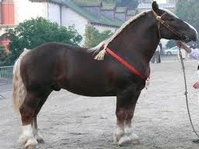 Breton horses, were originally bred for war, then were used for pulling stage coaches, and eventually for work in agriculture fields. They tend to be strong, intelligent, and dedicated, well, workhorses. The horses may not belong to a union, as such, but at Pontet-Canet, the working conditions seem good. I don’t want to anthropomorphize too much, but they do seem to enjoy the sun and the fresh air and human companionship. Their workdays are interspersed with frequent rests and energy treats. Doc, one of the Percherons who helps bring in the harvest at Oregon’s Illahe Vineyard, is even said to like the smell of wine. Another fan of Oregon Pinot Noir perhaps? Breton horses, were originally bred for war, then were used for pulling stage coaches, and eventually for work in agriculture fields. They tend to be strong, intelligent, and dedicated, well, workhorses. The horses may not belong to a union, as such, but at Pontet-Canet, the working conditions seem good. I don’t want to anthropomorphize too much, but they do seem to enjoy the sun and the fresh air and human companionship. Their workdays are interspersed with frequent rests and energy treats. Doc, one of the Percherons who helps bring in the harvest at Oregon’s Illahe Vineyard, is even said to like the smell of wine. Another fan of Oregon Pinot Noir perhaps?
Posted by Marguerite Thomas at 2:32 PM
|
|
 |
|